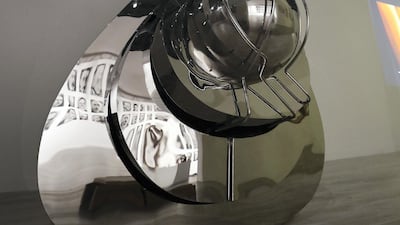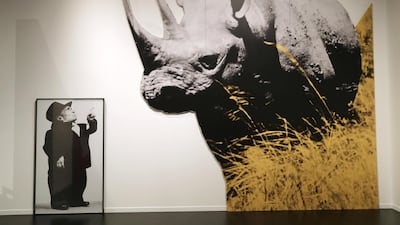Standing between German artist Gerhard Richter's monumental display of 48 great cultural figures of the western 20th century – all of whom are white and male, which is his point – and Mattar Bin Lahej's effusive metal sculpture of an exaggeratedly large oud, the director of the Museum of Contemporary Art Barcelona (MACBA) and his contemporary at the Emirates Fine Arts Society discuss emotion in art. Both agree that art needs more of it.
Ferran Barenblit, director of MACBA, and Nasser Abdullah, chairman of the Emirates Fine Arts Society, have co-curated historical and contemporary works from the MACBA collection alongside art from the Emirates. The show, at Manarat Al Saadiyat, explores the resonance between them.
From Barcelona to Abu Dhabi: Works from the MACBA Art Collection in Dialogue with the Emirates is the first time MACBA's collection has been shown in the Middle East. Barenblit, co-curator with Abdullah, stresses how they organised the show with the audience of the UAE in mind.
Many of the key works from the history of Conceptualism, which MACBA owns, are being shown here for the first time.
Pointing at a fragile, graceful wire sculpture by the Venezuelan artist Gego, Barenblit says: “This is probably the first time a Gego has been shown here – Gego! You can’t even imagine how important she is.”
Barenblit’s enthusiasm is pure MACBA. Since the museum was founded in 1995 – late for a major western museum – it has explored art histories that have functioned outside of the canon.
In doing so, it has gained a reputation as one of the most forward-thinking and important museums in Europe, and its choices of shows are carefully watched by curators and academics.
The Latin American artist Gego, for example, has never had a solo show at New York City’s Museum of Modern Art or London’s Tate Modern. Nor is she generally spoken about as a grandee of 20th century abstraction. “MACBA is not one more collection,” says Barenblit. “The idea from the beginning was not to replicate the same collections that were in Europe. We wanted to explore a parallel art history.”
Part of the reason for this was “practical,” he says. “When we started collecting, in the 1980s, the canonical works were no longer available, or they were unaffordable.” But it was also ideological: “MACBA defines itself as a museum that defies hegemonies.”
He concedes, however, that many of the less well-known artists MACBA collected have become “mainstream”. Barenblit comments: “It’s true. Just because – the museum was right. We did a very good job.”
The works that MACBA has brought to Abu Dhabi are by some of their most significant artists, such as John Baldessari, Juan Muñoz, Samuel Beckett, Bruce Nauman and Lawrence Weiner, with a text work hazarding some definitions of art that usually greets visitors to the Barcelona museum. MACBA had it translated to Arabic for the first time, and it now welcomes visitors to Manarat Al Saadiyat.
A beautiful installation by Hans-Peter Feldmann ruminates on the passing of time: 101 photographs each capture a subject at a different age, from a few months’ old to 100 years. A vase of flowers, drying as the exhibition wears on, sits in the middle of the room.
MACBA is known for its commitment to political work, which emerges in this exhibition often subtly or through the backdoor. Oussama Tabti's Stand By (2011) represents, by omissions, the years of war in Algeria.
For the work he photocopied books from a library in Algiers. Notable gaps in the time stamps on the books’ return dates – from 2008 to 2011 on one, 2006 to 2010 on another – suggest the dates when the war raged and the books were either not available to be borrowed, or no one was reading.
Abdullah and Barenblit divided the show into three themes: Figure, Environment and Form, and chose artists from their respective collections around each rubric. For Abdullah, it was a chance to show the history of Emirati art, in which the Emirates Fine Arts Society has played an important role.
The society was established in 1980, largely in response to the number of artists who were then returning from studying abroad, in places such as Egypt, Syria, Iraq, Kuwait, the United States and the United Kingdom.
“In 1980, when they all came back,” says Abdullah. “They wanted an umbrella under which to practice their art beside their job, and a place to exchange ideas and exhibit their work.”
“What was amazing with the Emirates Fine Arts Society was there were no schools of art in the country. If you had the education you had to give it to someone else. People used to teach, to help each other.”
Since 1980 the Society, which is headquartered in Sharjah, has held an annual exhibition (the 2018 show is currently running at the Sharjah Art Museum).
“The first generation are people like Hassan Sharif and Abdul Rahim Salem; then, you had a younger generation, like Mohammed Kazem, Abdullah Saadi and Karim Abdul Rahim; and now you have young artists coming and graduating from art schools in the country,” explains Abdullah.
“We selected around 20 artists for the show, including Hassan Sharif himself. It’s a nice combination between all three generations with different thoughts, different ideas, different concepts.” And for many of the works, he continues, “the dialogue with the MACBA collection was there already”.
The Dubai artist Shaikha Al Mazrou’s sculpture of a ball seemingly suspended in place by a cable, included in the Form section, speaks to the same ideas of abstraction and balance that the American artist Alexander Calder explored in the early 20th century, as in the two wood-and-iron assemblages shown here from 1931, from MACBA’s collection.
Barcelona artist Fina Miralles’s performance where she pushed a square turf of grass out to sea connects easily and happily with similar performances by Hassan Sharif and Mohammed Ahmed Ibrahim, the latter, Abdullah tells Barenblit, who once swapped squares of sand between the rocky deserts of the Emirates and Oman.
________________
Read more:
Abu Dhabi Festival announces line-up of major performances for 2018
Stills curated from the Arab Image Foundation’s archive reveal a bittersweet narrative
________________
Indeed, although this show admirably refuses an organising thesis, preferring to let the works speak for themselves, what is most evident from the collaboration is the push and pull between an international Conceptual art language and geographical specificity. The two countries’ works are clearly marked in the show – the floor beneath the galleries of work from the Emirates is varnished a tawny sand colour, while the MACBA galleries’ floor is black – but all the works could be seen as both speaking to their particular location and about art more broadly.
Some of the work by younger artists – youth is found mainly in the Emirates’ contribution – shows most clearly an engagement with Conceptual art history and local specificity, such as Farah Al Qasimi’s surreal image of a sand castle city in front of the JBR buildings in Dubai, which themselves look like they were built of sand. It is a similar use of fantasy and personal experience trumping objective mapping that Guy Debord and Guillermo Kuitca did on the MACBA side.
In the end, this is a show about art: about, as Barenblit puts it, “visuality and perception. People expect contemporary art to be difficult. But sometimes, art is much easier than it looks.”
From Barcelona to Abu Dhabi: Works from the MACBA Art Collection in Dialogue with the Emirates runs from February 2 to March 17 at Manarat Al Saadiyat. The show opens the 2018 Abu Dhabi Festival, organised by ADMAF. For more information, see manaratalsaadiyat.ae






